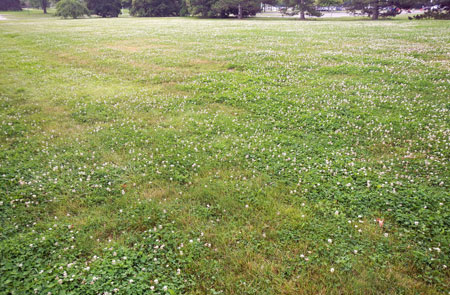Broadleaf weeds white clover and black medic are now flowering in turf
A long-term strategy to reduce white clover and black medic in turfgrass is to ensure adequate fertility levels.

As June has finally arrived so have two of the more persistent perennial broadleaf weeds. White clover (Trifolium repens) and black medic (Medicago lupulina) are flowering and infesting turf.
White clover and black medic are commonly found growing on low fertility, low maintenance sites such as roadsides, boulevards, home lawns, and in some cases golf course rough. Black medic and clover are very competitive in low fertility sites because they host rhizobacteria that fix atmospheric nitrogen into plant available nitrogen.
A long-term strategy to reduce their competitiveness in turf is to ensure adequate fertility levels. With the cool weather and frequent rainfall favoring cool-season turfgrass growth this spring, some lawns that haven’t received a fertilizer application since April are likely in need of a fertilizer application.
For cool-season turf in Michigan, at a minimum Michigan State University Extension suggest 2 pounds nitrogen (N) per 1,000 square-feet a year split over two applications to ensure the turf is dense and competitive. Depending on the turf use and inherent soil fertility, more than 2 pounds N per 1,000 square-feet may be necessary on many sites to produce a turf that is competitive with weeds.

White clover infesting turf. Photo credit: Kevin Frank, MSU
Although fall broadleaf herbicide applications are very effective for controlling white clover and black medic, many homeowners and turf managers don’t want to wait until fall to begin controlling weeds. Herbicides that have excellent activity for controlling black medic and white clover in home lawns include those that contain the active ingredients fluroxypyr, triclopyr or quinclorac.
Always read, understand, and follow the label directions. Mention or exclusion of specific products does not represent an endorsement or condemnation of any product by Michigan State University.
Dr. Frank's work is funded in part by MSU's AgBioResearch.



 Print
Print Email
Email


